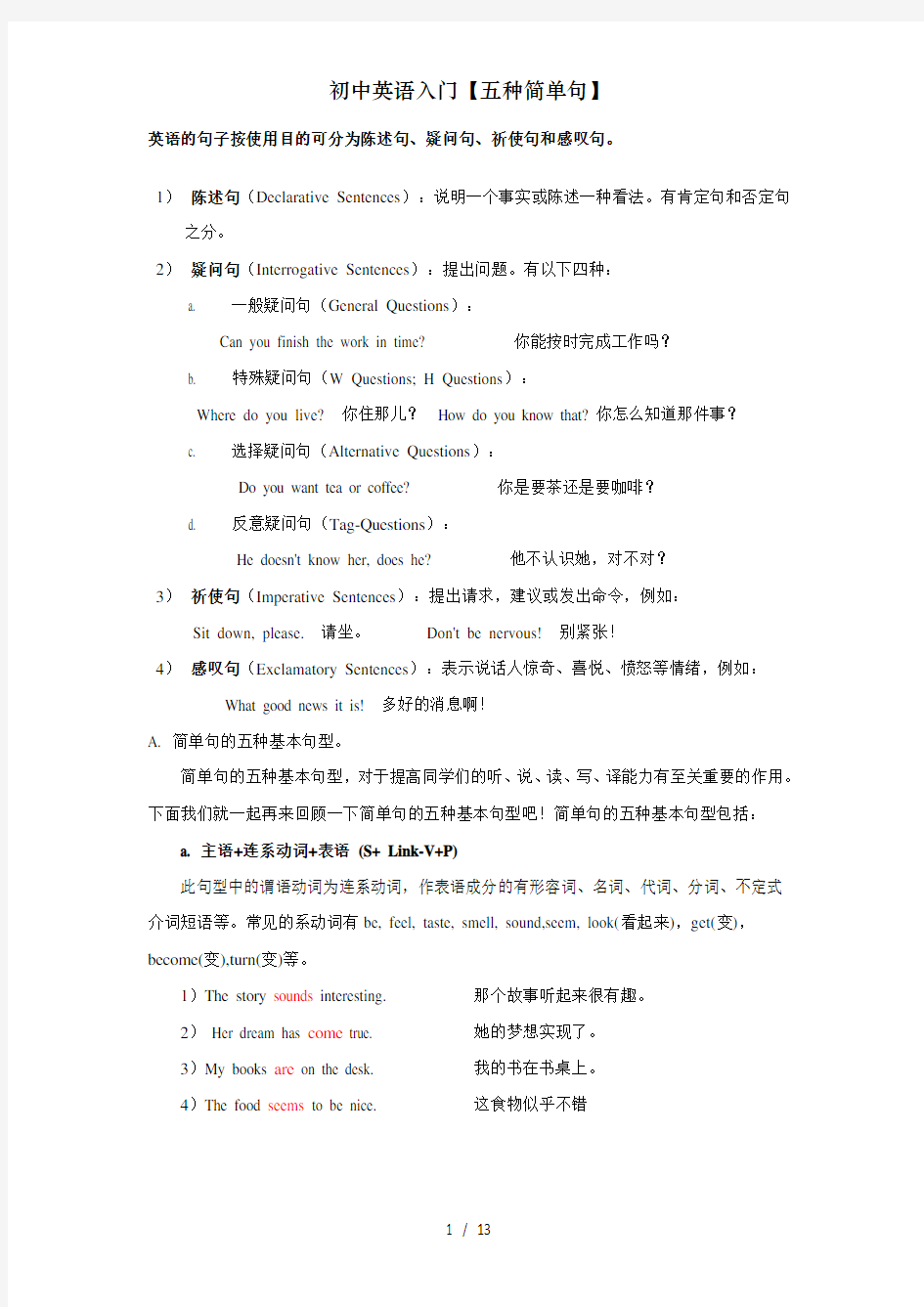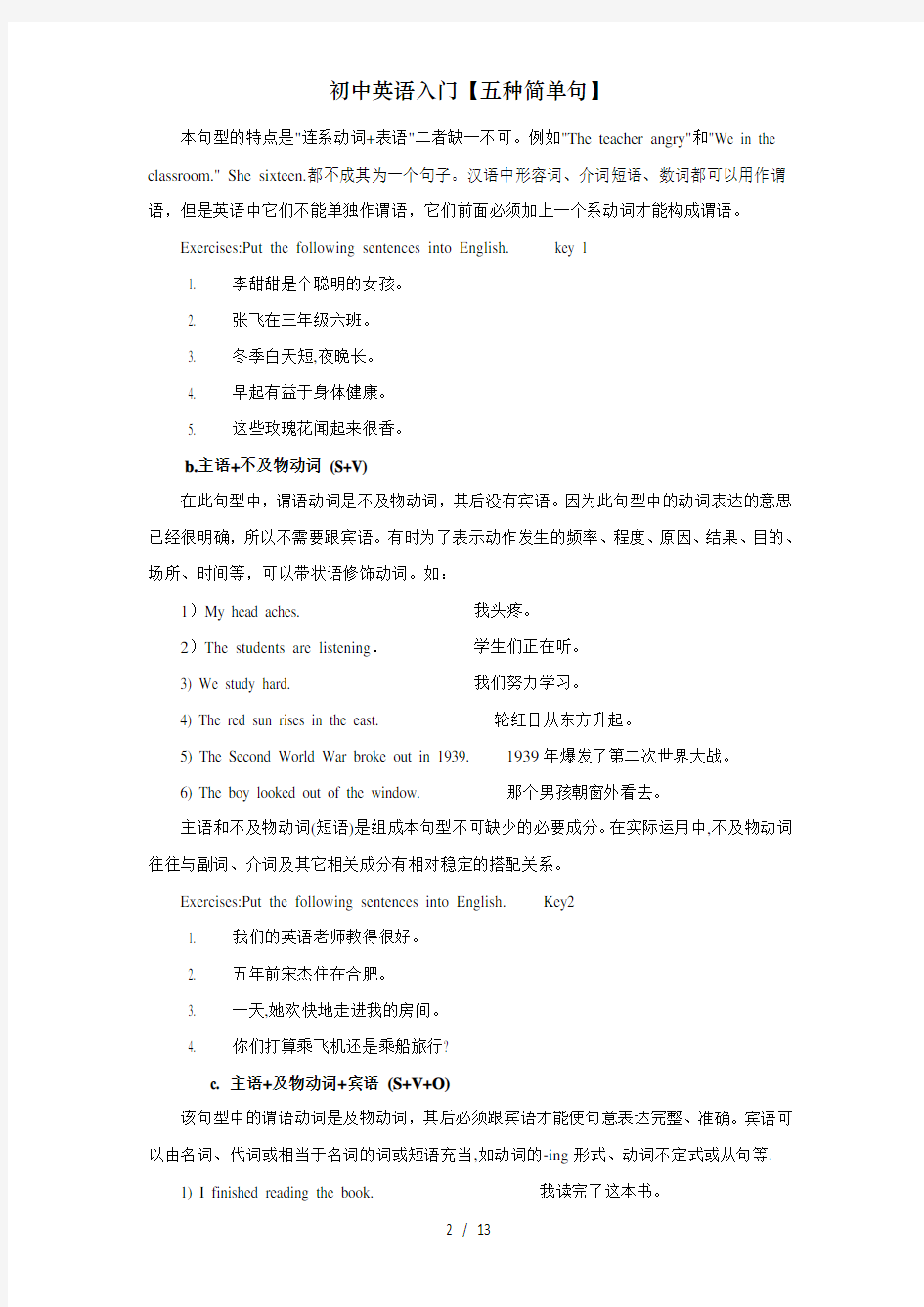

英语的句子按使用目的可分为陈述句、疑问句、祈使句和感叹句。
1)陈述句(Declarative Sentences):说明一个事实或陈述一种看法。有肯定句和否定句之分。
2)疑问句(Interrogative Sentences):提出问题。有以下四种:
a. 一般疑问句(General Questions):
Can you finish the work in time? 你能按时完成工作吗?
b. 特殊疑问句(W Questions; H Questions):
Where do you live?你住那儿? How do you know that? 你怎么知道那件事?
c. 选择疑问句(Alternative Questions):
Do you want tea or coffee? 你是要茶还是要咖啡?
d. 反意疑问句(Tag-Questions):
He doesn't know her, does he?他不认识她,对不对?
3)祈使句(Imperative Sentences):提出请求,建议或发出命令,例如:Sit down, please.请坐。Don't be nervous!别紧张!
4)感叹句(Exclamatory Sentences):表示说话人惊奇、喜悦、愤怒等情绪,例如: What good news it is!多好的消息啊!
A. 简单句的五种基本句型。
简单句的五种基本句型,对于提高同学们的听、说、读、写、译能力有至关重要的作用。下面我们就一起再来回顾一下简单句的五种基本句型吧!简单句的五种基本句型包括:
a. 主语+连系动词+表语(S+ Link-V+P)
此句型中的谓语动词为连系动词,作表语成分的有形容词、名词、代词、分词、不定式介词短语等。常见的系动词有be, feel, taste, smell, sound,seem, look(看起来),get(变),become(变),turn(变)等。
1)The story sounds interesting. 那个故事听起来很有趣。
2) Her dream has come true. 她的梦想实现了。
3)My books are on the desk. 我的书在书桌上。
4)The food seems to be nice. 这食物似乎不错
本句型的特点是"连系动词+表语"二者缺一不可。例如"The teacher angry"和"We in the classroom." She sixteen.都不成其为一个句子。汉语中形容词、介词短语、数词都可以用作谓语,但是英语中它们不能单独作谓语,它们前面必须加上一个系动词才能构成谓语。
Exercises:Put the following sentences into English. key 1
1. 李甜甜是个聪明的女孩。
2. 张飞在三年级六班。
3. 冬季白天短,夜晚长。
4. 早起有益于身体健康。
5. 这些玫瑰花闻起来很香。
b.主语+不及物动词(S+V)
在此句型中,谓语动词是不及物动词,其后没有宾语。因为此句型中的动词表达的意思已经很明确,所以不需要跟宾语。有时为了表示动作发生的频率、程度、原因、结果、目的、场所、时间等,可以带状语修饰动词。如:
1)My head aches. 我头疼。
2)The students are listening.学生们正在听。
3) We study hard. 我们努力学习。
4) The red sun rises in the east. 一轮红日从东方升起。
5) The Second World War broke out in 1939. 1939年爆发了第二次世界大战。
6) The boy looked out of the window. 那个男孩朝窗外看去。
主语和不及物动词(短语)是组成本句型不可缺少的必要成分。在实际运用中,不及物动词往往与副词、介词及其它相关成分有相对稳定的搭配关系。
Exercises:Put the following sentences into English. Key2
1. 我们的英语老师教得很好。
2. 五年前宋杰住在合肥。
3. 一天,她欢快地走进我的房间。
4. 你们打算乘飞机还是乘船旅行?
c. 主语+及物动词+宾语(S+V+O)
该句型中的谓语动词是及物动词,其后必须跟宾语才能使句意表达完整、准确。宾语可以由名词、代词或相当于名词的词或短语充当,如动词的-ing形式、动词不定式或从句等.
1) I finished reading the book. 我读完了这本书。
2) Do you like apples?你喜欢苹果吗?
3) We discussed it at the meeting last week. 上周我们在会上讨论过那件事。
4) He decided to buy a computer.他决定买一台电脑。
5) We love China. 我们爱中国。
6) They enjoyed themselves very much last night. 他们昨天晚上玩得很开心。
7) Do you remember his telephone number? 你记得他的电话号码吗?
8) He thought about the problem for a few moments. 他把这个问题思考了一会
儿。
注:不及物动词与介词连用时,其后也可跟宾语。例如:
Ann is waiting for Kate at school gate.安正在校门口等凯特。
主语和及物动词及其宾语是本句型的主干,至于及物动词,则既可以是单个的及物动词,也可以是短语动词。
Exercises: Put the following sentences into English. key 3
1. 她每天晚上看电视。
2. 这本书胡珊珊读过多次了。
3. 明天下午我们将进行英语考试。
4. 大多数人很喜欢轻音乐。
5. 她几乎不知道该如何写作文。
d.主语+及物动词+间接宾语+直接宾语(S+V+IO+DO)
英语中有些及物动词能跟双宾语,即间接宾语(指人) 和直接宾语(指物) 。通常情况下间接宾语在前,直接宾语在后。能跟双宾语的动词常见的有:
ask, bring, take, buy, cost, fetch, give, hand, pass, lend, offer, pay, read, save, send, show, teach, te ll, write等。有时也可把间接宾语置于直接宾语后,此时间接宾语前需加介词for或to。
1) Could you pass me the salt? (= Could you pass the salt to me?) 请你把盐给我好吗?
2) Uncle Wang made the farmers many machines.(=Uncle Wang made many machines for the farmers. ) 王叔叔给农民们制造了很多机器。
3) Zhou Nan lent me some money.(...some money to me.) 周楠借给我一些钱。
注意lend 和borrow 的区别。相对于主语而言,“借入”用borrow sth from sb. 相对于主语而言,“借出”用lend sb sth/ lend sth to sb.另外注意take 和bring的区别是针对说话人而言,“拿离说话人”,用take, “拿向说话人”用bring.
4) Mother bought me a new dress. (...a new dress for me.) 妈妈给我买了一件新衣
服。
5) The evening dress cost her forty dollars. 这件晚礼服花了她四十美元。
cost 的用法:1. cost sb (money/time)其中时间不能用具体多长时间,只能用模糊的时间段,比如some time/much time/a lot of time/all one’s life. 2. cost 不能用于被动语态的句子里。另外注意last, break out, belong to, take place, happen 等词很容易误用于被动语态,他们都不能被用于被动语态。3. cost 和belong to 都不能用于进行时态。
6) The girl asked me whether I could repair the bike. 那个女孩问我是否会修理自行
车。(直接宾语为句子)
7) He told me how to make a chair. 他告诉我如何做椅子。(直接宾语为不定式)
注:1.间接宾语后置与for连用的动词有buy, make, cook, get, choose, sing, find等。例如:
Uncle Li bought me a birthday present.(=Uncle Li bought a birthday present for me.) 李叔叔给我买了一件生日礼物。
2.间接宾语后置与to连用的动词有give, lend, teach, take, return, send, pass等。例如:Please pass him a cup of tea.(=Please pass a cup of tea to him.) 请递给他一杯茶。
3.间接宾语后置既可与for也可与to连用的动词有do, leave, write, bring等。例如:He brought me a dictionary.(=He brought a dictionary for/to me.)
他给我带来了一本词典。(bring 和take 的区别)
注:若直接宾语是人称代词时,通常情况下将其置于间接宾语之前。例如:
误:Please give me them.
正:Please give them to me.
Exercises: Put the following sentences into English. key 4
1. 刘江给了我一朵红玫瑰。
2. 她给我做了一件漂亮衣服。
3. 这项工作花了我们半个小时。
4. 吴老师给我们提出了一些有关英语学习的建议。